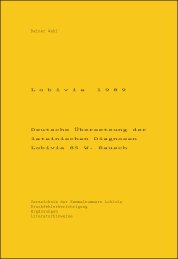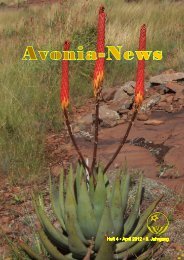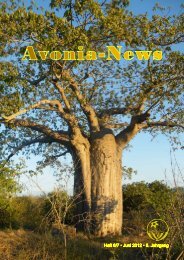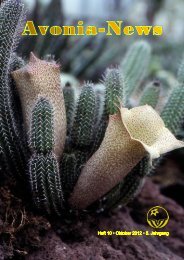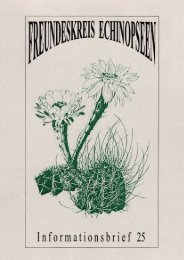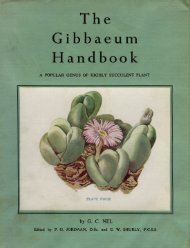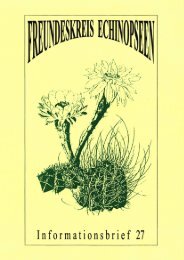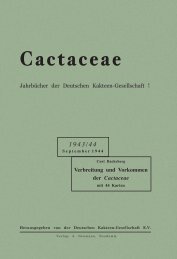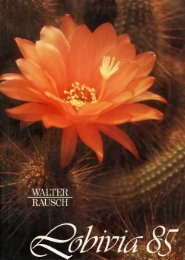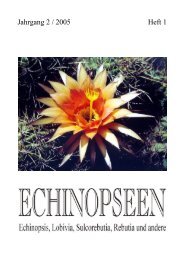VOLUME 14 :: January—October, 1952 Illustrations shown in ...
VOLUME 14 :: January—October, 1952 Illustrations shown in ...
VOLUME 14 :: January—October, 1952 Illustrations shown in ...
You also want an ePaper? Increase the reach of your titles
YUMPU automatically turns print PDFs into web optimized ePapers that Google loves.
16 THE CACTUS AND SUCCULENT January, <strong>1952</strong><br />
THE CRAZIEST THING THAT GROWS<br />
By NEIL M. CLARK<br />
(Repr<strong>in</strong>ted from the " Saturday Even<strong>in</strong>g Post " of April 7th, 1951, by special permission of The Curtis Publish<strong>in</strong>g<br />
Co., of Philadelphia, U.S.A.)<br />
The two deck hands stowed the last of the six cases <strong>in</strong> their assigned places. " Special handl<strong>in</strong>g," the labels<br />
said. One-by-twos nailed along the sides of the cases, jutted out at the ends for handles. Each case had small<br />
screened w<strong>in</strong>dows and was about the size and shape of a small doghouse with a gable roof.<br />
"Wonder what's <strong>in</strong> them ? " said the first hand.<br />
" Don't you know ? " said his mate scornfully. " This here's that new k<strong>in</strong>d of cactus. Grows on deserts an'<br />
don't hardly need no ra<strong>in</strong>. You feed cows on it, they get fat <strong>in</strong> no time. What you want to do, my lad, if you got<br />
a rich uncle that'll lend you a pile, is buy up a lot of this rotten-cheap land <strong>in</strong> Australia. Plant this cactus, buy cows<br />
an' lay back <strong>in</strong> yer hammock. In no time or less, yoj'H be richer'n Rockyfeller."<br />
Naturally, he didn't know a darn th<strong>in</strong>g about it. But he was repeat<strong>in</strong>g a dream that many a "smart " man<br />
has believed <strong>in</strong>, and that nobody except sharpsters has cashed <strong>in</strong> on yet. And <strong>in</strong> fact, as his quick eyes had discovered<br />
through the w<strong>in</strong>dows of f<strong>in</strong>e-meshed screen, the cases did conta<strong>in</strong> great fat stems of prickly-pear cactus. This<br />
strange cargo went aboard a steamer <strong>in</strong> the harbor of Buenos Aires <strong>in</strong> March, 1925. It sailed the high seas for ten<br />
weeks and <strong>14</strong>,000 miles, f<strong>in</strong>ally arriv<strong>in</strong>g at Sherwood, a suburb of Brisbane, <strong>in</strong> Australia. Actually, those six cases<br />
conta<strong>in</strong>ed a small company of remarkable " soldiers " dest<strong>in</strong>ed to w<strong>in</strong> one of the toughest wars ever waged aga<strong>in</strong>st<br />
one of man's life-and-death enemies—weeds—and they contributed as brilliant a chapter to the history of entomology<br />
as has been written s<strong>in</strong>ce bug study became a science.<br />
Years before, somebody carried a prickly-pear cactus of the species Opuntia <strong>in</strong>ermis to Australia ; nobody<br />
knows who, when or why. It was an odd plant, unknown <strong>in</strong> that part of the world, and seemed only a harmless<br />
curiosity. It is known that a pot of it was taken from Sydney to Scone, New South Wales, <strong>in</strong> 1839. Neighbors<br />
begged cutt<strong>in</strong>gs and planted them. They grew prolifically. Forty years later the cactus from that one pot had<br />
become tens of thousands of cactus plants, and they were beg<strong>in</strong>n<strong>in</strong>g to be considered an agricultural threat. In<br />
1893, Queensland declared cactus a noxious weed. By 1925 it had become one of the worst plagues ever to hit<br />
the island cont<strong>in</strong>ent, and it was estimated that it had occupied more than 60,000,000 acres, half of them so<br />
completely that other plants, or man, couldn't compete with it.<br />
Cactus, <strong>in</strong> short, was threaten<strong>in</strong>g to drive man right out. People desperately dug it up, burned it and dragged<br />
it out by the roots. It was so stubborn that an Australian soldier <strong>in</strong> California, <strong>in</strong>spect<strong>in</strong>g the so-called Burbank<br />
sp<strong>in</strong>eless cactus, warned wryly that <strong>in</strong> his homeland if you dug up a prickly-pear cactus and hung it high on a fence,<br />
it would grunt and stretch till its roots reached the ground, and the plant would go on grow<strong>in</strong>g. Many a settler<br />
had to give up his homestead, licked by cactus. Big hold<strong>in</strong>gs became memories on maps.<br />
All sorts of expedients were tried. Would cattle eat cactus ? They would if they had to. But it was found<br />
that all the cattle <strong>in</strong> Australia, eat<strong>in</strong>g only cactus, couldn't keep up with the annual <strong>in</strong>crease, let alone the old growth.<br />
Would chemicals kill it ? Yes, arsenic pentoxide could lick it, but the cost of kill<strong>in</strong>g cactus that way was around<br />
fifty dollars an acre, and most of the land wasn't worth a tenth of that. So they got around to the idea that maybe<br />
cactus-eat<strong>in</strong>g <strong>in</strong>sects would do the job without pay. World-wide studies were undertaken. Cactus is almost<br />
exclusively a native of the Americas ; it was almost unknown elsewhere before Columbus. But it has never been<br />
such a pest here as it became <strong>in</strong> Australia. Apparently it had American enemies, whether diseases or <strong>in</strong>sects, that<br />
kept it <strong>in</strong> check. What were they ? Could they be <strong>in</strong>troduced <strong>in</strong>to Australia ?<br />
Dur<strong>in</strong>g this period, some 350 <strong>in</strong>sects that throve on cactus were closely studied. The object was to f<strong>in</strong>d an<br />
<strong>in</strong>sect that was deadly to prickly-pear cactus, but harmed noth<strong>in</strong>g else, for any bug that could also live on wheat,<br />
grass, fruit or other economic plants could be an even worse pest than cactus. Detailed histories of literally<br />
hundreds of thousands of <strong>in</strong>dividual cactus-eat<strong>in</strong>g <strong>in</strong>sects were studied, and twelve k<strong>in</strong>ds were eventually established<br />
<strong>in</strong> Australia.<br />
The miracle bug, however, when he turned up, was more or less an accident. One member of the Australian<br />
commission happened to be travell<strong>in</strong>g briefly <strong>in</strong> the Argent<strong>in</strong>e, and located a few cocoons of an <strong>in</strong>sect said to be<br />
bad news for cactus, which went by the terrible name, Cactoblastis cactorum. Th<strong>in</strong>k<strong>in</strong>g anyth<strong>in</strong>g was worth<br />
try<strong>in</strong>g, he saved the cocoons, and <strong>in</strong> a few days butterfles emerged and laid eggs. It was those eggs that were shipped<br />
<strong>in</strong> the mysterious cases from Buenos Aires <strong>in</strong> March, 1925. They hatched as caterpillars dur<strong>in</strong>g the voyage. The<br />
cactus <strong>in</strong> the cases was there for the caterpillars to eat,



